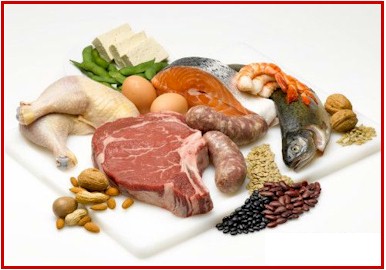
By Team ICG® Master Trainer Joan Kent
Everyone”™s idea of a healthful diet is somewhat different these days. Never before has there been so much information on nutrition or so much disagreement about it. Protein is important for a number of reasons.
The functions of protein are varied. The first eight below are in hierarchical order.
- Formation of dopamine, norepinephrine and epinephrine
- Immune support
- Formation of hormones
- Insulin receptor site turnover
- Reproductive demands
- pH balance
- Fluid balance
- Formation of enzymes
Other protein functions, in no particular order, include wound healing; tissue growth, repair and replacement; and the formation of neurotransmitters, transport proteins, blood proteins, visual pigments and nonessential amino acids.
Energy use is at the bottom of the hierarchy, although protein is the body”™s second largest store of energy. In times of stress, energy use becomes more important, and amino acids are converted to glucose to a greater degree.
Protein stimulates the release of glucagon. Glucagon is a hormone secreted by the pancreas. Its effects essentially oppose those of insulin, another hormone made by the pancreas. For example, insulin converts glucose and protein to fat for storage, while glucagon converts protein and fats to glucose and moves them into the bloodstream for use as fuel. Insulin increases the production of cholesterol, while glucagon decreases it.
Glucagon is typically released under two circumstances — when we exercise and when we eat protein.
Protein also promotes the release of CCK (cholecystokinin), a powerful satiety hormone that makes us feel full and also reduces the desire for carbohydrates. It was mentioned in an earlier post on sugar cravings that a low-protein diet is one reason people may crave sugar.
Protein is a significant mood enhancer because it increases levels of dopamine and norepinephrine. Protein provides tyrosine and phenylalanine, the amino acids used to produce these chemicals. As they told us in 7th grade biology, amino acids are “the building blocks of protein.”
Dopamine is our ultimate brain reward chemical, an alertness and feel-good chemical that, incidentally, is triggered by every addictive drug.
Norepinephrine is also associated with alertness and a feeling of brain reward. It has antidepressant properties. In fact, the earliest antidepressant drugs targeted norepinephrine levels. It”™s also an analgesic.
Protein provides tryptophan, another amino acid. Tryptophan is the amino acid that the brain uses to make serotonin. Serotonin makes us feel relaxed and calm. It”™s an antidepressant with anti-anxiety properties, as well. It, too, is an analgesic.
At high levels, serotonin can make us lethargic and sleepy and even bring on an early desire to quit endurance efforts. This has to do with the way tryptophan is transported to the brain. Carbs make that happen, but too many carbs raise serotonin levels too much. Protein can block that effect.
(BTW, Prozac and Zoloft target serotonin levels. The newest antidepressants target both serotonin and norepinephrine. You may have seen magazine ads or heard ads on radio or TV that say, “Depression hurts.” Depression doesn”™t cause pain. But because it”™s associated with brain chemicals that are also analgesics, low levels of the chemicals may exaggerate pain that”™s already in the body.)
Protein provides the B vitamins (thiamin, niacin, B6, folate) that are catalysts in the synthesis of dopamine, norephinephrine and serotonin.
With so many key actions by protein going on, it seems obvious that the body/brain needs substantial levels of protein. Nutrition recommendations sometimes underplay protein, which may reflect under-emphasis on protein”™s neurochemical effects.
A general protein recommendation for endurance athletes is to divide body weight in pounds by 2.2 to convert to kilograms, and multiply by 1.2 to 1.4 for daily grams.
High-protein foods include fish, poultry, beef, lamb, shrimp, crab, eggs, cottage cheese. If you”™d like to use yogurt as protein, the only two brands I know with significant protein are Fage and Trader Joe”™s nonfat Greek-style yogurt. Don”™t get “just any” Greek yogurt. Many of them have much more carb than protein, and the flavored ones contain lots of sugar.
Several foods are considered protein but actually aren”™t. One is cheese, which is primarily saturated fat. Nuts are another; they”™re primarily unsaturated fat. A third is quinoa, a whole grain that”™s primarily carb/starch.
These foods do have protein, but almost every food offers a combination of protein, carbs and fats — or at least two out of three. Using the example of quinoa, a food that”™s 70% carb with the remaining calories equally divided between protein and fat will have a completely different neurochemical effect than a food higher in protein.
I”™m not saying you shouldn”™t eat these foods; just don”™t confuse them with — or use them as — protein.
For many years, I”™ve recommended a “plate” format that the USDA”™s brand-new, Food Pyramid-replacing plate resembles. I steer away from the USDA version because it overemphasizes fruit.
Instead, cover half of your plate with vegetables and divide the other half equally between protein and complex starches (quinoa, sweet potatoes, brown rice, whole grain pasta, etc.). Add healthful fats (nuts, oils, seeds) in moderate portions. If you want to eat fruit instead of vegetables, say at breakfast, have a serving, rather than half a plate. One serving is a medium-size fruit or half a cup.
My main suggestion is to find high-quality protein foods that you like and include some with every meal or snack. The plate format should make it easy to do.
- New Year’s Resolutions: A Sugar Addict’s Survival Guide - April 15, 2024
- Motivation vs. Enthusiasm - October 12, 2023
- Why Exercise Shouldn’t Be Just One Thing - November 9, 2022
